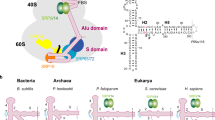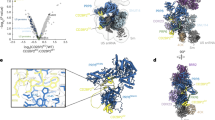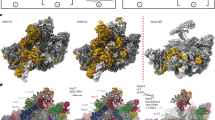Abstract
The Alu domain of the mammalian signal recognition particle (SRP) comprises the heterodimer of proteins SRP9 and SRP14 bound to the 5′ and 3′ terminal sequences of SRP RNA. It retards the ribosomal elongation of signal-peptide-containing proteins before their engagement with the translocation machinery in the endoplasmic reticulum. Here we report two crystal structures of the heterodimer SRP9/14 bound either to the 5′ domain or to a construct containing both 5′ and 3′ domains. We present a model of the complete Alu domain that is consistent with extensive biochemical data. SRP9/14 binds strongly to the conserved core of the 5′ domain, which forms a U-turn connecting two helical stacks. Reversible docking of the more weakly bound 3′ domain might be functionally important in the mechanism of translational regulation. The Alu domain structure is probably conserved in other cytoplasmic ribonucleoprotein particles and retroposition intermediates containing SRP9/14-bound RNAs transcribed from Alu repeats or related elements in genomic DNA.
This is a preview of subscription content, access via your institution
Access options
Subscribe to this journal
Receive 51 print issues and online access
$199.00 per year
only $3.90 per issue
Buy this article
- Purchase on Springer Link
- Instant access to full article PDF
Prices may be subject to local taxes which are calculated during checkout





Similar content being viewed by others
References
Walter, P. & Blobel, G. Signal recognition particle contains a 7S RNA essential for protein translocation across the endoplasmic reticulum. Nature 299, 691–698 (1982).
Walter, P. & Johnson, A. E. Signal sequence recognition and protein targeting to the endoplasmic reticulum membrane. Annu. Rev. Cell Biol. 10, 87–119 (1994).
Lütcke, H. Signal recognition particle (SRP), a ubiquitous initiator of protein translocation. Eur. J. Biochem. 228, 531– 550 (1995).
Gundelfinger, E. D., Krause, E., Melli, M. & Dobberstein, B. The organization of the 7SL RNA in the signal recognition particle. Nucleic Acids Res. 11, 7363–7374 ( 1983).
Siegel, V. & Walter, P. Removal of the Alu structural domain from signal recognition particle leaves its protein translocation activity intact. Nature 320, 81– 84 (1986).
Thomas, Y., Bui, N. & Strub, K. A truncation in the 14 kDa protein of the signal recognition particle leads to tertiary structure changes in the RNA and abolishes the elongation arrest activity of the particle. Nucleic Acids Res. 25, 1920–1929 (1997).
Mason, N., Ciufo, L. F. & Brown, J. D. Elongation arrest is a physiologically important function of signal recognition particle. EMBO J. 19 , 4164–4174 (2000).
Rapoport, T. A., Heinrich, R., Walter, P. & Schulmeister, T. Mathematical modeling of the effects of the signal recognition particle on translation and translocation of proteins across the endoplasmic reticulum membrane. J. Mol. Biol. 195, 621–636 (1987).
Emde, G., Frontzek, A. & Benecke, B. J. Secondary structure of the nascent 7S L RNA mediates efficient transcription by RNA polymerase III. RNA 3, 538–549 (1997).
Chen, Y., Sinha, K., Perumal, K., Gu, J. & Reddy, R. Accurate 3′ end processing and adenylation of human signal recognition particle RNA and Alu RNA in vitro. J. Biol. Chem. 273, 35023–35031 (1998).
Jacobson, M. R. & Pederson, T. Localization of signal recognition particle RNA in the nucleolus of mammalian cells. Proc. Natl Acad. Sci. USA 95, 7981– 7986 (1998).
Dunham, I. et al. The DNA sequence of human chromosome 22. Nature 402, 489–495 ( 1999).
Weiner, A. M., Deininger, P. L. & Efstratiadis, A. Nonviral retroposons: genes, pseudogenes, and transposable elements generated by the reverse flow of genetic information. Annu. Rev. Biochem. 55, 631–661 (1986).
Kazazian, H. H. Jr Mobile elements and disease. Curr. Opin. Genet. Dev. 8, 343–350 ( 1998).
Bovia, F., Fornallaz, M., Leffers, H. & Strub, K. The SRP9/14 subunit of the signal recognition particle (SRP) is present in more than 20-fold excess over SRP in primate cells and exists primarily free but also in complex with small cytoplasmic Alu RNAs. Mol. Biol. Cell 6, 471–484 ( 1995).
Chang, D. Y., Hsu, K. & Maraia, R. J. Monomeric scAlu and nascent dimeric Alu RNAs induced by adenovirus are assembled into SRP9/14-containing RNPs in HeLa cells. Nucleic Acids Res. 24, 4165–4170 (1996).
Bovia, F., Wolff, N., Ryser, S. & Strub, K. The SRP9/14 subunit of the human signal recognition particle binds to a variety of Alu-like RNAs and with higher affinity than its mouse homolog. Nucleic Acids Res. 25, 318–326 ( 1997).
Kremerskothen, J. et al. Heterodimer SRP9/14 is an integral part of the neural BC200 RNP in primate brain. Neurosci. Lett. 245, 123–126 (1998).
Birse, D. E., Kapp, U., Strub, K., Cusack, S. & Åberg, A. The crystal structure of the signal recognition particle Alu RNA binding heterodimer, SRP9/14. EMBO J. 16 , 3757–3766 (1997).
Weichenrieder, O., Kapp, U., Cusack, S. & Strub, K. Identification of a minimal Alu RNA folding domain that specifically binds SRP9/14. RNA 3, 1262–1274 ( 1997).
Strub, K., Moss, J. & Walter, P. Binding sites of the 9- and 14-kilodalton heterodimeric protein subunit of the signal recognition particle (SRP) are contained exclusively in the Alu domain of SRP RNA and contain a sequence motif that is conserved in evolution. Mol. Cell. Biol. 11, 3949– 3959 (1991).
Cusack, S. et al. Small is beautiful: protein micro-crystallography. Nature Struct. Biol. 5, 634–637 (1998).
Pley, H. W., Flaherty, K. M. & McKay, D. B. Three-dimensional structure of a hammerhead ribozyme. Nature 372, 68–74 (1994).
Scott, W. G., Finch, J. T. & Klug, A. The crystal structure of an all-RNA hammerhead ribozyme: a proposed mechanism for RNA catalytic cleavage. Cell 81, 991–1002 (1995).
Wimberly, B. T., Guymon, R., McCutcheon, J. P., White, S. W. & Ramakrishnan, V. A detailed view of a ribosomal active site: the structure of the L11–RNA complex. Cell 97, 491–502 (1999).
Conn, G. L., Draper, D. E., Lattman, E. E. & Gittis, A. G. Crystal structure of a conserved ribosomal protein–RNA complex. Science 284, 1171–1174 ( 1999).
Strub, K. & Walter, P. Assembly of the Alu domain of the signal recognition particle (SRP): dimerization of the two protein components is required for efficient binding to SRP RNA. Mol. Cell. Biol. 10, 777–784 ( 1990).
Siegel, V. & Walter, P. Each of the activities of signal recognition particle (SRP) is contained within a distinct domain: analysis of biochemical mutants of SRP. Cell 52, 39–49 (1988).
Zwieb, C., Müller, F. & Larsen, N. Comparative analysis of tertiary structure elements in signal recognition particle RNA. Fold. Des. 1, 315–324 (1996).
Chang, D. Y., Newitt, J. A., Hsu, K., Bernstein, H. D. & Maraia, R. J. A highly conserved nucleotide in the Alu domain of SRP RNA mediates translation arrest through high affinity binding to SRP9/14. Nucleic Acids Res. 25, 1117– 1122 (1997).
Strub, K. & Walter, P. Isolation of a cDNA clone of the 14-kDa subunit of the signal recognition particle by cross-hybridization of differently primed polymerase chain reactions. Proc. Natl Acad. Sci. USA 86, 9747–9751 ( 1989).
Andrews, D. W., Walter, P. & Ottensmeyer, F. P. Evidence for an extended 7SL RNA structure in the signal recognition particle. EMBO J. 6, 3471–3477 (1987).
Nakamura, K., Yahagi, S., Yamazaki, T. & Yamane, K. Bacillus subtilis histone-like protein, HBsu, is an integral component of a SRP-like particle that can bind the Alu domain of small cytoplasmic RNA. J. Biol. Chem. 274, 13569–13576 (1999).
Strub, K., Fornallaz, M. & Bui, N. The Alu domain homolog of the yeast signal recognition particle consists of an Srp14p homodimer and a yeast-specific RNA structure. RNA 5, 1333–1347 (1999).
Siegel, V. & Walter, P. Binding sites of the 19-kDa and 68/72-kDa signal recognition particle (SRP) proteins on SRP RNA as determined in protein–RNA “footprinting”. Proc. Natl Acad. Sci. USA 85, 1801–1805 (1988).
Mighell, A. J., Markham, A. F. & Robinson, P. A. Alu sequences. FEBS Lett. 417, 1–5 (1997).
Leslie, A. G. W. Joint CCP4 & ESF-EACBM Newsletter on Protein Crystallography No. 26 (Daresbury Laboratory, Warrington, UK, 1992).
Navaza, J. AMoRe: an automated package for molecular replacement. Acta Crystallogr. A 50, 157–163 ( 1994).
Brünger, A. T. et al. Crystallography & NMR system: A new software suite for macromolecular structure determination. Acta Crystallogr. D 54, 905–921 (1998).
Perrakis, A., Morris, R. & Lamzin, V. S. Automated protein model building combined with iterative structure refinement. Nature Struct. Biol. 6, 458–463 (1999).
Jones, T. A., Zou, J. Y., Cowan, S. & Kjeldgaard, M. Improved methods for building protein models in electron density maps and the location of errors in these models. Acta Crystallogr. A 47, 110–119 (1991).
Otwinowski, Z. & Minor, W. Processing of X-ray diffraction data collected in oscillation mode. Methods Enzymol. 276, 307–326 ( 1997).
de la Fortelle, E. & Bricogne, G. Maximum-likelihood heavy-atom parameter refinement for multiple isomorphous replacement and multiwavelength anomalous diffraction methods. Methods Enzymol. 276 , 472 –494 (1997).
Abrahams, J. P. & Leslie, A. G. W. Methods used in the structure determination of bovine mitochondrial F1 ATPase. Acta Crystallogr. D 52, 30–42 (1996).
Carson, M. RIBBONS 2.0. J. Appl. Crystallogr. 24, 958 –961 (1991).
Esnouf, R. M. An extensively modified version of MolScript that includes greatly enhanced coloring capabilities. J. Mol. Graph. 15, 133–138 (1997).
Merritt, E. A. & Bacon, D. J. Raster3D: photorealistic molecular graphics. Methods Enzymol. 277, 505–524 (1997).
Nicholls, A., Sharp, K. A. & Honig, B. Protein folding and association: insight from the interfacial and thermodynamic properties of hydrocarbon. Proteins 11, 281–296 (1991).
Acknowledgements
O.W. received a pre-doctoral fellowship from the Boehringer-Ingelheim-Fonds. K.S. is supported by a START subsidy and a grant from the Swiss National Science Foundation and the Canton de Genève. K.S. and S.C. are both principal investigators belonging to SRPNET, a research network of the European Union Training and Mobility in Research program, which also supported K.W. We thank members of the EMBL/ESRF Joint Structural Biology Group (JSBG) and the staff of BM30 and ID13 for support on ESRF beamlines; in particular, A. Thompson for the europium MAD experiment and A. Perrakis for the ID13 measurements and help with wARP. C. Petosa commented critically on the manuscript.
Author information
Authors and Affiliations
Corresponding author
Supplementary Information
Rights and permissions
About this article
Cite this article
Weichenrieder, O., Wild, K., Strub, K. et al. Structure and assembly of the Alu domain of the mammalian signal recognition particle. Nature 408, 167–173 (2000). https://doi.org/10.1038/35041507
Received:
Accepted:
Issue Date:
DOI: https://doi.org/10.1038/35041507
This article is cited by
-
A Role for the Mutagenic DNA Self-Catalyzed Depurination Mechanism in the Evolution of 7SL-Derived RNAs
Journal of Molecular Evolution (2017)
-
Conserved 3′ UTR stem-loop structure in L1 and Alu transposons in human genome: possible role in retrotransposition
BMC Genomics (2016)
-
Translational arrest by a prokaryotic signal recognition particle is mediated by RNA interactions
Nature Structural & Molecular Biology (2015)
-
Strukturelle Evolution des Signalerkennungspartikels
BIOspektrum (2015)
-
Autoimmune Diseases and Polyamines
Clinical Reviews in Allergy & Immunology (2012)
Comments
By submitting a comment you agree to abide by our Terms and Community Guidelines. If you find something abusive or that does not comply with our terms or guidelines please flag it as inappropriate.



